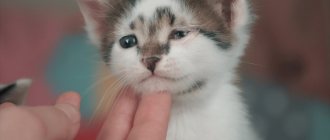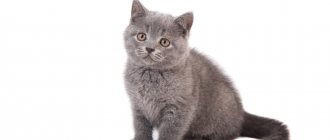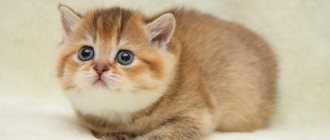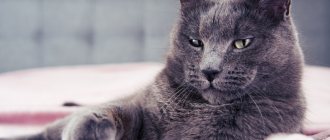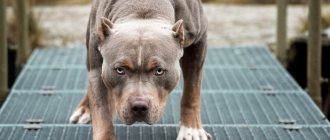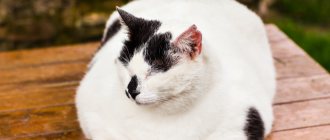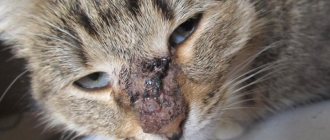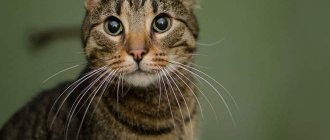What is the problem: main reasons
Veterinarians claim that the main source of hernial protrusion in kittens are anomalies that occur during intrauterine development, which is why the disease is largely congenital in nature. Acquired pathology is possible only in adult cats.
When the owners notice a protruding navel in a kitten, this may indicate a hernial protrusion. The following factors can influence the pathological process:
- Genetic predisposition. A bulging belly in a cat in the first months of life is a consequence of the characteristics of genes, the development of which is disrupted even in the womb. With such a violation, the umbilical ring is formed incorrectly, which is why the ligaments and veins may subsequently fall out.
- Improper handling of the umbilical cord when giving birth to a cat. Often, owners decide to interfere with the birth process in animals, which can lead to unpleasant consequences. If the umbilical cord is cut incorrectly, then there is a high probability of an increase in the diameter of the umbilical ring, as a result of which a hernia soon occurs.
- Increased pressure inside the peritoneum. It is a common cause of problems in kittens, as well as adult pets. Such a violation is possible with regular constipation, prolonged vomiting or increased stress.
- Various injuries and mechanical damage. Symptoms of an umbilical hernia in small animals can appear after a fall from a height, a strong blow or a bruise, as a result of which the abdominal muscles are stretched and the internal organs are displaced.
This is interesting: Causes of elevated amylase in the blood of cats
Reasons for appearance
Hernia in cats can be congenital or acquired. The congenital form of the disease occurs due to abnormal development of internal organs, as well as weakness of the muscle corset. Other causes of congenital hernia:
- Presence of genetic predisposition. Deviations in the genetic code lead to the fact that during intrauterine development anomalies occur in the formation of the umbilical vein.
- Incorrect cutting of the umbilical cord when a kitten is born, which causes the umbilical ring to expand. The umbilical cord is cut incorrectly by the pet owner, or the cat, which has given birth for the first time and does not have the proper experience, unsuccessfully gnaws it.
Acquired hernia. Most often in mustachioed striped animals there is an acquired type of disease that occurs as a result of provoking factors:
- previous surgical operations on the abdominal organs, removal of organs, improper care of the pet during the rehabilitation period - postoperative type of hernia;
- complications arising after the sterilization procedure;
- mechanical damage to the abdominal cavity, trauma;
- prolonged constipation, flatulence, developing due to poor nutrition;
- increased intra-abdominal pressure due to impaired bowel movements and frequent vomiting;
- numerous pregnancies with a short break, childbirth with complications.
Often a hernia appears in older individuals as a result of weakening muscle fibers that can no longer contain the internal organs.
Why does it occur
Umbilical hernia in kittens ranks first in frequency of occurrence, although seals can also appear in the scrotum, perineum, and side.
It is believed that the main cause of an umbilical hernia is the insufficient development of the abdominal muscles and connective tissue, which are unable to hold the internal organs in place.
Also, prolapse can occur through a poorly formed, too wide or incompletely closed umbilical ring, which is a consequence of an intrauterine developmental defect. The cause of non-union is often an unsuccessful break of the umbilical cord by the mother cat, especially if she gives birth for the first time and has no experience in caring for newborns.
Factors contributing to the formation of a hernia:
- birth injury,
- genetic predisposition,
- Excessive internal pressure on the abdominal muscles due to persistent constipation, vomiting or diarrhea when the abdominal walls contract violently.
What is an umbilical hernia
A hernia is the partial prolapse of internal organs under the skin through openings formed naturally or due to injury. The umbilical differs in that it is recognized in the navel area. In this case, a loop of intestine sticks out. The umbilical ring is poorly formed, which makes the formation noticeable and palpable.
Umbilical hernia in a kitten
Diagnostic procedures
In addition to palpation, pathology in an animal can be detected using ultrasound.
Only a veterinarian can distinguish an umbilical hernia in a kitten from other pathological disorders. If unpleasant symptoms appear, you should contact a veterinary clinic. Often, to make a final diagnosis, it is enough for a specialist to conduct a visual examination of the pet and palpate the abdomen. To assess the condition of internal organs and the severity of the disorder, additional laboratory and instrumental diagnostic methods can be performed. The basis for diagnosing an umbilical hernia in a kitten is ultrasound examination.
Treatment
There are 2 options for solving the problem: conservative and surgical. The choice of method depends on the size of the hernia on the kitten’s abdomen. Treatment is carried out only by a veterinarian. With the conservative method, the doctor prescribes massage, rubbing of ointments and reduction of the hernia. It should be carried out by a veterinarian; doing it yourself is not recommended. The repaired hernia is fixed and they wait for the moment when the ring into which the organs prolapsed heals. If this does not happen, then surgery must be performed.
Surgical excision of the hernial sac is called herniotomy. This is the most effective and least dangerous way to solve the problem. These operations are not difficult; even yesterday’s student can handle them. Complications after surgery are rare; after a couple of weeks, the cat will not even remember the visit to the clinic. After the procedure, the animal should wear a blanket for 8-14 days.
What to do and how to treat the deviation?
Conservative treatment
It is possible to remove hernial protrusion in small individuals at an early stage using conservative methods. For this purpose, the pet is prescribed medications and ointments with an irritating effect. A cat's hernia on her stomach will go away faster if you regularly massage the hernial ring. After manual reduction of the formation, it is necessary to use a special patch that provides fixation. If the pericardial hernia is small, it can heal on its own in the kitten by 6 months after birth.
When is surgery required?
Basically, this pathology is eliminated by performing a herniotomy on the animal.
As a rule, conservative therapy for pathological disorders in young felines is ineffective. It is important to understand that in advanced cases, removing a tumor in the navel area is possible only through surgical intervention. Such surgery is known in veterinary medicine as herniotomy, during which the hernial sac is removed using a scalpel. This technique gives the most positive results and is performed under general anesthesia. It is not recommended to remove a hernia in the abdominal area using local anesthesia, since the kitten may feel pain. The operation is performed in a veterinary clinic, and complications occur in rare cases. Surgical intervention for umbilical hernia is performed in the following sequence:
- The surgeon uses a scalpel to excise the skin above the umbilical ring. A small hernial protrusion requires a straight incision, while a large neoplasm requires a spindle-shaped incision.
- The peritoneal tissue is peeled off and the internal organs are inserted into the abdominal cavity.
- The lumen is reduced, then sutures are placed.
Surgery to remove a hernia is performed on male cats after they reach one month of age. Females can have the tumor removed at six months. If there is a threat of necrosis of vital organs, then radical treatment may be performed earlier.
Prevention
It is impossible to completely exclude the occurrence of a hernia in a cat, especially when it comes to internal pathologies and heredity. But maintaining general health and following doctors' recommendations will help reduce the risks:
- exclude from breeding animals prone to or suffering from hernias;
- do not overfeed the cat - this increases the pressure in the abdominal cavity;
- promptly resolve problems with bowel movements and bladder emptying;
- avoid injuries - secure windows with mosquito nets, block access to cabinets;
- castrate animals not participating in the breeding program;
- Avoid giving birth more than once every year and a half.
It is important to vaccinate your pet on time, treat it against parasites, and take it for annual preventive examinations. This will help avoid systemic diseases that lead to the formation of a hernia.
Consequences
The owner should pay attention to the health of a small pet if it meows all the time and looks restless.
If a kitten's umbilical hernia is not removed in a timely manner, it often becomes complicated and leads to irreversible damage. Complications can also appear after surgery if the pet is not provided with proper care and treatment of the wound, as a result of which the suture festers or comes apart. Seroma is also likely to occur, in which serous fluid accumulates. With the active growth of the cone, the intestines and other internal organs are pinched. Owners should be alert to the following unpleasant symptoms:
- restless kitten and frequent meowing;
- refusal to eat or vomiting immediately after a meal;
- inflammatory reactions with fever.
This is interesting: What to do if a cat’s kidneys fail?
Types of surgical interventions
It is worth saying that there are many types of diseases that require surgical intervention. Let's outline the most basic ones:
- pathological (complicated) childbirth;
- castration and sterilization, urethrostomy and cystotomy;
- suturing wounds resulting from a fight;
- docking and amputation;
- various types of neoplasms, etc.
Preparing the dog for surgery
Operation for a dog
- This is a serious blow to the body. Therefore, before deciding whether it is necessary, the veterinarian must make sure that there are no alternative options. To do this, a careful examination and samples are taken.
Much depends on the pet owner
It is important to understand that childbirth, which takes place under the supervision of a specialist, is one of the guarantees that the offspring will grow up healthy; timely treatment and suturing of the wound will allow an infection to begin, which will lead to serious consequences
Call our clinic, and we will make sure your dog is healthy!
Surgery will be more effective and painless for your pet if you properly prepare him for surgery. 12 hours before the operation begins on the dog, you need to stop feeding it. It is also not recommended to drink water, as anesthesia can cause side effects: shortness of breath and vomiting.
If your dog has previously had complications coming out of anesthesia, tell your doctor. Also let your veterinarian know in advance about any medications your dog is taking. This may need to be stopped some time before surgery.
Care and recovery of a pet after surgery
As a rule, the younger the dog, the easier it will be for him to recover from anesthesia.
When your pet's movements have become confident and conscious, it is important to take care of her comfort and calm. It is important to limit physical activity and adjust your diet, following the recommendations of your veterinarian
Caring for your dog after surgery begins with taking the temperature. In case of elevated temperature, it is necessary to carefully examine the seam for the development of inflammation or other complications.
If you notice redness and swelling, it is important to consult your doctor as quickly as possible.
www.vetmir.ru
What does it look like
A hernia can be reducible, or it can be irreducible. Depending on the type, the symptoms of the pathology will differ.
Reducible is characterized by the mobility of the seal:
- when pressed, it easily moves inside the abdomen;
- when assuming a dorsal position, the lump spontaneously disappears, as its contents are drawn back into the abdominal cavity;
- Stroking does not cause pain to the pet.
Signs of an umbilical hernia
Important! With this type of pathology, it is always possible to assess the size, location and shape of the hole through which the prolapse occurred.
An irreducible hernia occurs when:
- the formation of adhesions between the hernia membrane and its contents,
- the presence of an inflammatory process inside the “bump”,
- infringement of contents resulting from sudden jumps, unsuccessful falls, etc.
The bulge is painful, hot to the touch, has a constant shape and increases over time. The animal is worried and may vomit.
It is necessary to understand that the strangulated area is deprived of normal blood circulation, this in turn leads to tissue death and the subsequent development of peritonitis.
Important! In case of an irreducible or strangulated hernia, surgery is inevitable and the sooner it is performed, the more favorable the further prognosis. Trying to straighten such protrusions is strictly contraindicated!
Complication of untreated hernia
Failure to treat a hernia can result in pinching, which, in turn, disrupts the blood supply to the affected organ and can lead to its atrophy or rupture. Damage to the urinary tract or uterus in a female threatens intoxication of the body.
If pinched, a pet may die within a few hours or minutes from painful shock. Only urgent surgical intervention will save him.
Causes of hernias in kittens
What factors influence the appearance of a hernia? There are quite a few reasons for the development of the disease:
- Transmission of the disease by inheritance. Veterinarians believe that if at least one of the parents (cat) has a congenital hernia, then this pathology is likely to be passed on to at least one kitten from the litter;
- Congenital pathology of the peritoneum;
- Intestinal problems (constipation, increased gas formation);
- Incorrect (too short) cutting with scissors or the cat biting off the umbilical cord;
- Injury to the peritoneal area (falls, dog bites, bruises, etc.).
Diaphragmatic hernia
With a diaphragmatic hernia in a cat, the abdominal organs shift into the thoracic cavity. This usually occurs through the weakest points in the diaphragm (esophageal opening and areas of attachment to the sternum, spine and ribs). In cats, a diaphragmatic hernia most often occurs as a result of an injury (fall from a height), after surgery, etc.
Symptoms. With a diaphragmatic hernia, the cat becomes lethargic and apathetic. Attacks of shortness of breath or suffocation appear, breathing becomes fast and shallow. As a result of attacks of shortness of breath due to oxygen starvation, the cat develops cyanosis of the visible mucous membranes. With a strong diaphragmatic hernia, pulmonary edema develops as a result of compression of the lungs by the abdominal organs.
The diagnosis of diaphragmatic hernia is made on the basis of clinical signs with mandatory confirmation by additional studies - x-rays, ultrasound, MRI.
Treatment. Treatment for diaphragmatic hernia is only surgical. During the operation, a veterinarian opens the chest cavity and returns all organs that have entered the chest cavity from the abdominal cavity to their place. The diaphragm is sutured and repaired, by applying a special mesh or using your own tissue. In case of infringement, organs are subject to resection. After surgery, long-term rehabilitation is necessary due to a collapsed lung and poor circulation in the chest cavity.
Prevention . In order to prevent the occurrence of hernias in cats, owners must take timely measures to treat diseases of the digestive and defecatory organs. Carefully monitor the cat's movement in the room, do not leave windows open and do not let the cat out onto the lodge, especially if you live on the upper floors. Provide your cat with a balanced diet. Avoid frequent births in your cat and limit the number of matings.
Types of pathologies
There are two categories of hernias - congenital and acquired. The latter in adult cats are formed against the background of injuries (blows, falls) and malfunctions of the digestive system associated with an improper diet.
Based on location, there are several types of hernias:
- Umbilical. In most cases, it is congenital, but there are also acquired ones, resulting from an improperly cut umbilical cord or pathology that has developed in the intestines. The most common type.
- Intervertebral (the rarest type). Typical for old cats (over 15 years old). Modern medicine has the possibility of treatment with medications (subject to timely diagnosis).
- Inguinal. Formed due to flatulence and frequent constipation. Less dangerous for cats than for cats.
- Diaphragmatic. Causes: mechanical damage, trauma. Characterized by the transition of organs from the abdominal cavity to the chest.
- Perineal. The location is between the bladder and rectum. Since pinching does not occur, the tumor is not operated on, but reduced.
- Pericardial-peritoneal. A congenital and extremely rare species. With this diagnosis, kittens do not survive, since the hernia puts pressure on the heart, which provokes heart failure and pulmonary edema.
Regardless of the type of disease, it cannot be ignored: if it progresses, it causes a purulent abscess and, as a consequence, the death of the animal.
Perineal hernia
With a perineal hernia, the contents of the hernial sac can be the uterus, bladder, omentum, or intestinal loop. This type of hernia occurs in a cat as a result of excessive and repeated straining of the abdominal press due to constipation, diarrhea, proctitis, etc. In most cases, this type of hernia is reducible.
Symptoms. In cats, a unilateral or bilateral swelling protrudes under the anus, and in cats, this swelling appears under the genital opening. On palpation, this hernia is soft in consistency and painless. If the cat is lifted by the thoracic limbs, the hernia will increase, and when lifted by the pelvic limbs, it will decrease or disappear completely. The hernial orifice is the pelvic protrusion of the peritoneum. The contents of the hernial sac can be the bladder, omentum, intestinal loops, and uterus.
Treatment. For small hernias, treatment of animals is not carried out, since strangulation of the hernial contents practically does not occur. For large hernias, an operation is performed - herniotomy, the essence of which is as follows: the hernial sac is prepared, sutured, crimping its wall on the threads of knotted sutures, capturing a gap of 2-3 cm in each of them. In this case, first a seam is placed on the tops, then three to four seams around it, then six to seven seams are placed in a large circle and a thick layer of fabric is obtained, which is lowered deep into the pelvis, the threads are cut off. Gradually, the operated animal develops a dense scar, which prevents the displacement of the underlying organs.
Protrusion in adult animals
An umbilical hernia in a cat on the stomach is quite rare; inguinal and perineal types occur more often. There are many reasons for this:
- difficult birth,
- multiple pregnancy, when the pressure on the abdominal wall increases significantly,
- constipation, in which the animal constantly strains,
- problems with urination,
- abdominal injuries
- operations on internal organs.
Hernia removal
You should know it! An inguinal hernia is localized between the last nipples and the pubic bone, a perineal hernia is located between the bladder and the anus.
According to the nature of the manifestation, it happens:
- reducible - the swelling is usually soft, painless, mobile;
- irreducible (strangulated) - the protrusion thickens and causes discomfort; the animal constantly licks the painful area and worries.
Treatment depends on the severity of the disease, as in the case of the umbilical, it can be conservative or surgical:
- a perineal hernia is corrected by suturing the hernial opening,
- small groins are observed and not treated in any way; if the condition worsens, they resort to surgical excision.
Sometimes a hernia in a cat can form after sterilization, which is a postoperative complication. In this case, next to the suture, a kind of lump forms under the skin, consisting of prolapsed intestinal loops without signs of inflammation.
Typically, protrusion occurs for two reasons:
- due to excessively rapid resorption of suture material;
- improperly performed internal suture technique.
With this type of pathology, you have to resort to re-suturing the postoperative wound.
Inguinal hernia
An inguinal hernia (Herniae inguinalis) occurs in cats that suffer from constipation and flatulence; in cats, an inguinal hernia is more often a birth defect. For the most part, this pathology in cats is not dangerous. Due to the fact that the hernial sac in most cases is filled with omentum. However, things don't always work out so well. In some animals, abdominal organs begin to protrude through the inguinal canal, and in pregnant cats, a pregnant uterus may become trapped in the inguinal hernia. Cats with an inguinal hernia have the potential to remain infertile.
Symptoms. During the clinical examination, the veterinarian palpates a soft, painless swelling between the last nipple and the anterior edge of the pubic bones. With a wide inguinal ring, this swelling may disappear after pressing on it. When strangulated, the inguinal hernia becomes denser and more painful on palpation. Externally, the cat often lies down and licks the surface of the hernia. All other signs of this complication appear more strongly in a cat when a loop of intestine or bladder is pinched.
The diagnosis of an inguinal hernia is made by a veterinarian based on the symptoms of the disease.
Treatment. To perform the operation, the cat is fixed in a dorsal position. The operation is performed under combined anesthesia. The veterinarian makes an incision in the skin and subcutaneous tissue along the greater curvature of the swelling, 5-6 cm long, and then dissects the hernial sac to the hernial ring. Expansion of the hernial ring, if necessary, is done only in the anterolateral area. In its caudal area, it is necessary to avoid injury to the external pudendal arteries and veins. The hernial sac is twisted along the longitudinal axis, bandaged as high as possible and the ligature cut off below. Knotty sutures made of biocompatible polymer threads “Kapromed” are applied to the edges of the hernial ring. The wound cavity is sutured and the operation is completed by applying a knotted silk suture to the skin.
Clinical picture
Each of the above types of hernias has characteristics of its course, by which it will not be difficult to determine the pathology. At the initial stage, the hernia is very small, soft, invisible and practically does not manifest itself at all. The cat leads a normal lifestyle and does not experience discomfort. If the hernia can be diagnosed early in the disease, it can be repaired.
In the future, as the disease develops, the cat may experience hyperthermia, weakness, and lethargy. Experiencing discomfort, the animal constantly licks the area with the tumor. An overgrown hernia can become inflamed.
When the intestines are strangulated, constipation, weight loss, and dehydration are observed. If the bladder is affected, urination may be uncontrollable and difficult, and abdominal pain may appear.
An umbilical hernia is often accompanied by vomiting, indigestion, and pain upon palpation of the abdomen.
An intermediate hernia does not cause any inconvenience to the pet, the animal’s behavior does not change. You can detect it visually: if you hold the cat by the front paws, the hernia will protrude.
Intervertebral hernia has a pronounced clinical picture. The owner notices that the cat has poor coordination of movements. The animal shows less activity, it is difficult for her to walk and jump. In severe cases, complete or partial paralysis of the limbs, damage to the spinal cord tissue and central paralysis may occur.
With a diaphragmatic hernia, which makes breathing difficult and causes oxygen starvation, the animal’s mucous membranes turn blue. In severe cases, pulmonary edema is diagnosed.
How to rid your pet of a hernia
What to do if your dog has a hernia? What actions can the owner take at home to help the pet? The answer is clear: the owner must, without taking any action, quickly show the pet to the veterinarian. Folk remedies, massages, and self-reduction of hernias are excluded. Treatment of a hernia in a dog
– a serious matter that can be done by a competent specialist.
In most cases, after diagnosis, doctors offer surgical treatment for hernias. And only if the hernia is umbilical and very small, a specialist can use a conservative method of treatment: moving the protruding organs into place and suturing the natural or acquired opening - the hernial orifice.
In case of a perineal or inguinal hernia, surgery will be required to remove the hernial sac and, possibly, its contents (necrotic parts of the affected organs). This intervention will be performed under general anesthesia.
With a diaphragmatic hernia, the organs moved to the thoracic region return to their “rightful” place, after which the diaphragm is sutured. Intervertebral hernia is also treated surgically, removing all tissue that puts pressure on the spinal cord. Almost always removing a hernia in dogs
combined with drug therapy (anti-inflammatory, painkillers, immunomodulators, laxatives if necessary).
Classification of species
Umbilical hernia varies in severity and can be reducible or irreducible. The first type is characterized by the absence of pain and easily returns to the peritoneum with slight pressure. If the kitten is turned onto its back, such a hernia will retract on its own, and the belly will become flat.
Why does a kitten's whiskers break: the main reasons and what to do
An irreducible tubercle causes pain and discomfort. The formation is hot, if touched, almost motionless. Due to the inflammatory process inside, it may gradually increase in size.
Reference! A reducible hernia can develop into a second type of hernia due to the onset of inflammation inside the formation. Additionally, adhesions and pinching may form.
Preventive measures
Veterinary ointments and massage will help prevent the disease. Usually, a veterinarian who discovers a small bulging tumor covers it with an adhesive bandage, thereby preventing the development of the disease. The doctor may also suggest giving the animal an injection, which will eliminate the risk of reoccurrence of the hernial opening.
Remember that a kitten suffering from this pathology cannot be used to produce offspring in the future, since the disease can be passed on to the next generation.
A hernia in a small kitten is a fairly common disease; its size can reach several centimeters. Sometimes it is difficult for the owner of the animal to immediately notice a tumor on the stomach or in the groin area due to its small size or if the kitten has a rich coat. Therefore, at least once a year it is necessary to show your pet to a veterinarian to prevent the most common and serious pathologies in cats.
This article has been checked and approved by a veterinarian. Knyazeva Anna Vladimirovna, veterinarian in private practice, Moscow. more about the expert.
(you can vote for the article)
Tags: hernia, cat health, kitten, cats
- Related Posts
- Can cats be jealous?
- How to make cat food at home
- Why does a cat cough: reasons and how to treat
Animals that are at risk
It is better to prevent every disease in advance, otherwise you cannot avoid long-term treatment. Newborn kittens whose umbilical cord has just fallen off are at risk. To avoid the development of the disease, you should massage your newborn kitten. And kittens who have already suffered from the disease should follow the preventive procedures recommended by the veterinarian.
Pregnant cats are at risk.
A pregnant cat with an umbilical hernia is at particular risk
The tissues of the abdominal wall become more elastic, which subsequently enlarges the umbilical ring and the hernial sac. Midway through a cat's pregnancy, the uterus becomes larger, causing it to become pinched.
If an animal has suffered from this disease, then it should not be bred. In most cases, the offspring will be carriers of this disease.
Read with this
Fractures in dogs are a common pathology encountered by a veterinary specialist.
Unfortunately, almost every owner is faced with a situation where a pet, while walking, steps on a splinter or sharp object and injures its paw. In this case, the dog can receive either a small unnoticeable scratch or a serious wound.
Lameness in dogs is one of the most common problems caused by changes in gait due to gait dysfunction in one or more limbs. Usually this can be immediately detected, since the animal presses the sore paw, or rests only partially on it
Pyometra is a form of purulent inflammation of the endometrium, accompanied by the accumulation of pus in the uterine cavity. All animals are susceptible to the disease, regardless of birth history. There is no risk of development in sterilized cats that have had their ovaries removed along with their uterus. Pyometra is a life-threatening condition.
Pyometra is an inflammation of the endometrium, accompanied by the accumulation of pus in the uterine cavity and general intoxication of the body. One of the most common diseases of the reproductive system in bitches, without treatment often leads to the death of the animal. Mostly dogs over 5 years of age are affected.
www.vodoleyvet.ru
How to tell if a kitten has a hernia
A recently appeared hernia in a kitten can go unnoticed by the owner for a long time. The thing is that at first the protrusion of the internal organs does not bring any discomfort to the animal, and it is quite difficult to externally examine the small ball on the tummy of a young pet. In advanced cases, the hernia appears in the kitten as a large soft or elastic formation in the abdominal area
. Things get even worse when the hernia becomes pinched. Then the unfortunate kitten may have the following symptoms:
- Severe pain in the abdominal area (a small pet may show discomfort by meowing pitifully, cowering and arching its back);
- Problems with bowel movements (constipation) and/or urination;
- Temperature increase;
- Refusal to eat;
- Apathy;
- Nausea and vomiting;
- In some cases, breathing problems;
- There may be changes in gait and problems with coordination.
It is also worth mentioning that a symptom of a strangulated hernia is the inability to reduce the contents of the hernial sac inward. In this case, the formation on the abdomen itself will be hard to the touch.
Diagnostics
To determine the contents of the hernial sac, the doctor taps it with his fingers and listens (auscultation). If it is reduced, the size of the gate (hole) is assessed. For greater information, even with external pathology, hardware diagnostics are required - ultrasound, x-ray, CT, depending on the location.
Before treating a hernia, tests are taken from the cat to determine its general condition - clinical signs and biochemistry of urine and blood. It is advisable to show your pet to a cardiologist, especially if its age exceeds 7 years. It is not recommended to operate on kittens before six months, but in complicated cases there is no choice.
Diagnosis of the disease
Diagnosis is carried out using an external examination. The hernia is always visible; it looks like a new growth in the navel area. It is also necessary to determine the type of disease. A reducible hernia is movable when pressed and may disappear when the pet changes body position. The cat feels good due to the absence of pain.
The irreducible one has a convex shape that increases in size over time. It is hot to the touch and causes a lot of discomfort in the animal.
Care after hernia removal
Surgery to remove a hernia in cats.
After surgery to remove a hernia, the dog will have a certain rehabilitation period, depending on where the operation was performed:
- Postoperative treatment of sutures is carried out according to the instructions of the operating physician, taking into account what surgical material was used to apply the sutures and what kind of wound treatment was performed at the end of the operation.
- If areas of organs or tissues with necrosis are removed, antibiotic therapy is mandatory.
- After inguinal and perineal hernias, if the intestinal loops have been strangulated, a diet is indicated - feeding easily digestible food, excluding dry food and those that can provoke fermentation, flatulence, colic, etc.
- After removal of a hernia, the dog must be provided with complete rest for the first day or two after the operation, and then a long-term regime without strong physical activity. This regime should be observed for as long as indicated by the veterinarian who operated and knows the condition of the internal organs. After spinal surgery, such a gentle regimen can be indicated for life. Too active games, intense running, and jumping are undesirable.
- According to indications, it is mandatory to wear special postoperative bandages, which will not only protect the stitches from being licked by the pet itself, but also maintain the result of the operation until the complete healing and tightening of the muscular frame of the diaphragm, abdominals, inguinal folds, etc.
- For the first 2-3 days, the animal may need painkillers. This is not a prerequisite, you need to look at the condition of the animal: ketanov (0.5 ml/20 kg);
- traumatin (0.1 ml/kg, but not more than 4 ml);
- Rimadyl (1 tablet/5 kg orally).
Sometimes uncomplicated hernias can be eliminated by repositioning the organs, however, the risk of their reoccurrence remains. To prevent this from happening, surgical removal of the hernia is usually recommended. Small holes in the muscle walls are more dangerous due to the possibility of entrapment; they require surgery as urgently as large ones.
If the organs cannot be easily returned to the abdominal cavity, or the hole does not close, or complications develop (inflammation, blockage, strangulation), surgery becomes necessary.
If the hernia removal is not urgent, in preparation for the operation, the veterinarian performs urine and blood tests, determines the general state of health, and treats existing diseases.
The night before surgery, you should limit your cat's water intake as the anesthesia is administered with intravenous drugs. Once the cat is asleep, a tracheal tube is inserted through which gas is injected to maintain anesthesia. The skin in the area where surgery will be performed is shaved and cleaned. Surgical drapes are used to maintain sterility during surgery.
During the operation, the doctor returns the protruding organs to the abdominal cavity, after checking that they are not damaged and are viable. If there are damages, actions are taken to restore them, then the gap in the muscle walls is closed. Closing the gap can be done with existing muscle tissue, or with the use of synthetic surgical mesh, used if the hole is too large or if dead parts must be removed. Stitches are then placed to close the skin incision.
To treat or prevent infection, antibiotics are prescribed before and after surgery, if necessary. To prevent damage to the seams from licking and combing, use an Elizabethan collar.
We suggest you read: Asher cat as an ideal pet
After surgery, painkillers and sedatives may be prescribed. Typically, postoperative care is straightforward and long-term hospitalization after surgery is not required.
After removing the hernia, you will need to monitor the condition of the suture. Redness, tenderness, or discharge may indicate post-operative infection. Bleeding means the presence of hemorrhage. Medicines (painkillers, anti-inflammatory, antibiotics) should be used strictly as prescribed by a veterinarian.
Typically, recovery proceeds without complications that slow down recovery. To achieve the best results, you need to limit your cat's activity for several weeks.
The operation ensures that the hernia will not form again. Most cats recover completely after a hernia is removed, and complications are rare. Possible problems include postoperative infections, bleeding, and suture dehiscence. Good postoperative care and control significantly reduces the risk of their occurrence.
When recovering from a hiatal hernia, there is a risk of aspiration, which can lead to pneumonia, so cat owners should be aware of the signs. Removal of uncomplicated hernias is often combined with sterilization of animals, so as not to resort to additional anesthesia.
Have you been trying to heal your JOINTS for many years?
Head of the Institute for Joint Treatment: “You will be amazed at how easy it is to heal your joints by taking every day...
Surgery
Surgical excision is the most radical way to eliminate the formation. General and local anesthesia is used for the operation. The veterinarian chooses the appropriate option after examining the pet.
The essence of the operation is to cut the skin. If the hernia is small, the incision is made straight. For large formations, a spindle-shaped one is used. When the tissues are peeled off, the doctor moves the organs to the peritoneal area, where they should be.
Then the lumen of the ring near the navel is reduced and sutures begin.
For cats, surgery can be performed at the age of 1 month or later, and for cats no earlier than six months. In serious cases, it is permissible to have surgery earlier.
Prevention of hernia in kittens
Treatment of umbilical hernia in a cat
After diagnosing and making an accurate diagnosis, it is necessary to begin treating a hernia in the cat’s stomach.
Important! It is forbidden to try to treat an animal yourself, without consulting a doctor. You cannot carry out thermal procedures or try to straighten protruding organs with your own hands.
Conservative methods
Conservative therapy involves the use of ointment, the use of a special therapeutic massage of the affected area and the application of a plaster to fix the area after reduction.
In a kitten, with good treatment, the hernia can close by 6 months. In other cases, for older individuals, conservative treatment is not enough.
Folk remedies
The most effective folk method is to straighten the affected area and fix it with a plaster. Additionally, use a flat, dense object, such as a coin or button, to make the fixation more reliable. In a young pet, with a small hernia, it heals.
Hernia prevention
Preventive measures will help to avoid hernial sacs on the cat’s body, and, accordingly, surgical intervention in the body will not be necessary. Of course, this does not apply to congenital pathology in a kitten.
The animal must have a properly selected diet that eliminates problems with digestion and bowel movements.
Frequent childbirth provokes hernia formations, so it is necessary to limit the number of matings in the female.
An open balcony and window are a risk of injury to the purr.
If abdominal surgery has been performed, the animal must be provided with comfort and care. You will also need to limit the cat's activity until complete recovery.
Take care of your beloved cats!
